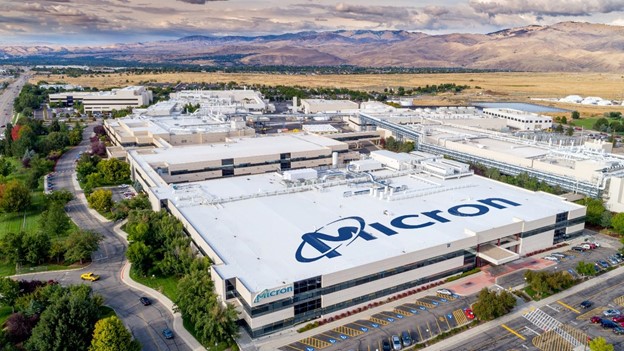Chipmaker Micron (MU) reported results Tuesday, March 29 after the close. The company reported iQ2 results which end in February. This means MU results post before peers. This provides market participants invaluable information ahead of the primary reporting period
Micron designs, manufactures, and sells memory and storage products. It provides DRAM and NAND products.
- NAND is non-volatile memory. This saves data when power is removed. For example, when your phone is turned off. NAND is primarily used for permanent storage in mobile devices.
- DRAM is volatile memory which means it can only save data when it has power. It is temporary storage for PCs, servers, and mobile devices.
- Peers include Western Digital (WDC) and Seagate Technologies (STX).

Q2 Results
Micron delivered an excellent performance in Q2. Revenue was approximately $7.8 billion, up 1% q/q and up 25% y/y. Revenue was particularly strong in client and cloud markets.
Q2 DRAM revenue was $5.7 billion, representing 73% of total revenue. DRAM revenue increased 2% q/q and was up 29% y/y. Sequentially, bit shipments increased in the high single-digit percentage range, while ASPs declined in the mid-single-digit percentage range.
Q2 NAND revenue was $2 billion (25% of revenue). NAND revenue increased 4% q/q and 19% y/y. Sequential bit shipments were flat, and ASPs increased in the mid-single-digit percentage.
- Datacenter revenue grew more than 60% year-over-year, supported by robust demand across the DRAM and SSD portfolio.
- GPU revenues grew year-over-year driven by strong demand for the latest generation of gaming consoles and graphics cards.
- Q2 mobile revenue grew slightly year-over-year as the 5G transition continues in smartphones. MU noted some weakness in the China market as the local economy slows, smartphone market share shifts, and some customers take a more prudent approach to inventory management.
- Auto revenue set a record. Auto unit production remains below demand, constrained by numerous supply chain challenges, including logic and analog semiconductor component shortages.
Margins and Cash Flow
The consolidated gross margin for fiscal Q2 was 47.8%, up approximately 80 basis points q/q. Gross margins benefited from improvements in product mix.
Q2 operating income was strong at $2.8 billion, resulting in an operating margin of 35%, flat q/q, and up from 20% in the prior year. Q2 adjusted EBITDA was $4.5 billion, resulting in an EBITDA margin of 58%, up from 57% in the prior quarter and up from 45% in the prior year.
Micron generated $3.6 billion in cash from operations in fiscal Q2, representing 47% of revenue. Free cash flow for fiscal Q2 was strong at slightly over $1 billion. The company remains confident in its ability to generate significant free cash flow in the second half of the fiscal year and believes it will be substantially higher than that in the first half.
This is notable as MU has returned $5.8 billion or 64% of cumulative free cash flow over the past year. It expects to return more than 50% of the cross-cycle free cash flow through a combination of dividends and buybacks.
Demand
Micron noted demand for memory and storage is broad, extending from the data center to the intelligent edge and to a growing diversity of user devices. Last year, data center became the largest market for memory and storage, eclipsing the mobile market. Micron expects data center demand growth to outpace the broader memory and storage market over the next decade.
The automotive and industrial segments are expected to be the fastest-growing memory and storage markets over the next decade. These markets make up more than 10% of MU revenues. As stated on the call, “New EVs are becoming like data center on wheels”.
The mobile 5G shift continues to be positive for average capacities. And even though mobile is not going to be a big driver of growth sequentially in FQ3, the company does expect it to pick up sequentially in FQ4 because of seasonality. The mobile commentary will have investors taking a closer look at Apple suppliers and semiconductor companies that rely heavily on mobile customers.
The Supply Chain
Supply chain concerns around semis remain but Micron has strategically diversified its supply chain over the last several years and maintains appropriate inventories of materials and noble gases. It does do not expect any negative impact on near-term production volumes because of the Russia-Ukraine war.
MU stated nonmemory component shortages are improving, and it believes further improvements should support memory and storage demand growth for the rest of this year. However, there are some pockets where semiconductor shortages have not improved as fast as expected, and the company expects these shortages to continue into the calendar year 2023.
There are cost challenges stemming from supply chain and inflationary pressures, which will limit cost reductions this year for the industry. MU cost reductions did outpace analyst expectations. Other chip companies may not have been as effective in reducing expenses. MU noted more modest front-end cost reductions in Q3 on a sequential basis due to the pull-in of cost reductions in Q2.
Outlook
MU expects Q3 revenue to be in the range of $8.5-8.9 billion which is better than the $8.1 billion street expectations and will represent a new record for quarterly revenues. Gross margins are expected to be in the range of 47-49%, and operating expenses to be approximately $1.05 billion.
The gross margin guidance midpoint is higher sequentially reflecting the company’s belief it can continue to manage costs while sustaining pricing power. Both DRAM and NAND gross margins are expected to increase sequentially in fiscal Q3.
Micron reiterated 2022 CapEx will be in the range of $11 billion to $12 billion.
Conclusion
Micron grew revenue and margins sequentially while driving favorable mix and cost reductions amid ongoing global supply chain challenges. The company is on track to deliver record revenue and robust profitability in fiscal 2022 and remains well-positioned to create significant shareholder value in fiscal ’22 and beyond.
Overall business is tracking ahead of plans for a quarter and demand is strong across most end markets with some regional challenges. Near-term supply and pricing trends are constructive.
Shares of MU jumped 5% in response to the positive report but ran into resistance at the 50-day moving average ($84). The stock rallied 10% ahead of its print so some sell the news should not be surprising. MU should see support at the 200-sma ($79) which is a good area for investors to accumulate.
There are no signs of demand for storage drying up which means MU has a long path of revenue growth and profitability. This should correspond to healthy capital returns at a minimum with upside potential in the stock.



